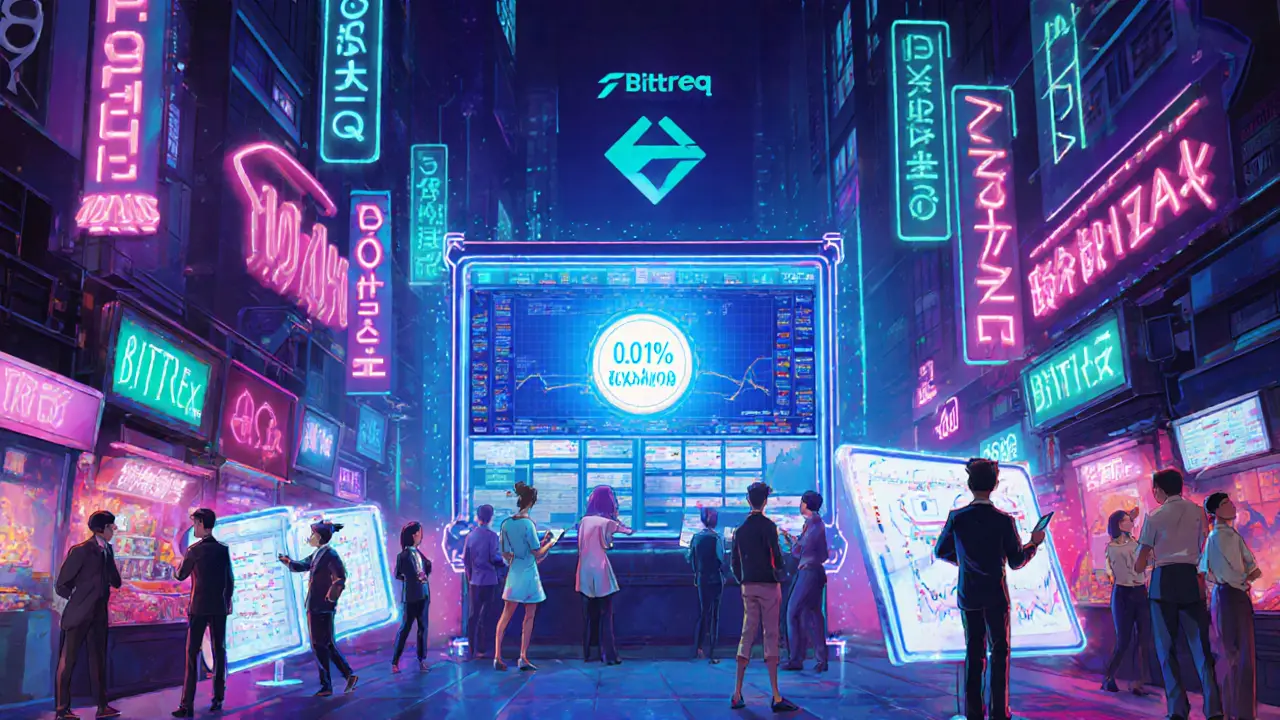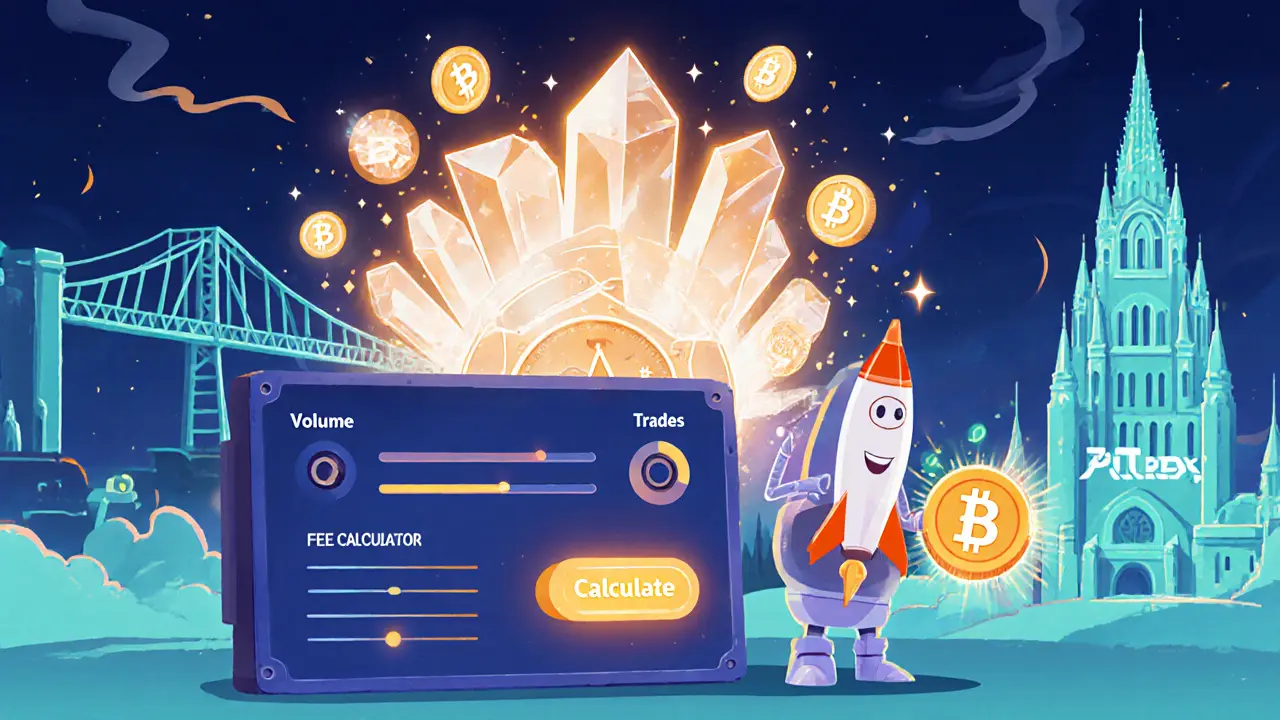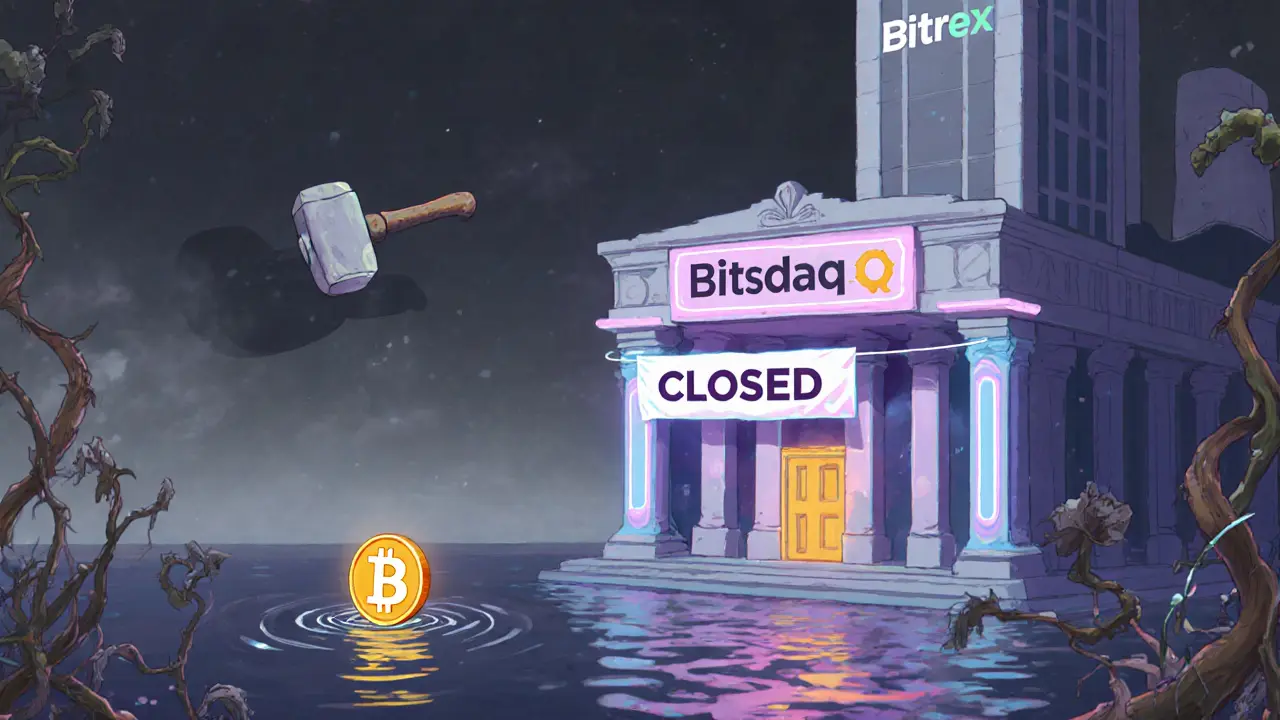
Bitsdaq Trading Fee Calculator
Trade Volume Calculator
Estimate your trading costs on Bitsdaq vs. other exchanges based on your monthly trading volume.
Estimated Monthly Trading Costs
| Exchange | Fee Rate | Estimated Cost |
|---|
Key Insights About Bitsdaq
- Fee Flat 0.10% trading fee - below industry average of 0.25%
- Liquidity Shared order book with Bittrex provided deep liquidity
- Security Multi-layer encryption and key fragmentation
- Token BQQQ token raised $6.5M in IEO with $55M market cap
- Shutdown Closed in October 2025 due to liquidity issues and regulatory pressure
Bitsdaq crypto exchange review - you’re probably wondering what happened to the once‑promising pan‑Asian platform and whether its low‑fee model was any good. This article breaks down the exchange’s features, token economics, security setup, fee structure, competitive standing, and the reasons it shut down for good.
TL;DR Snapshot
- Bitsdaq launched with over 300 crypto pairs but required crypto‑only deposits.
- Flat trading fee: 0.10% for makers&takers - well below the 0.25% industry average.
- Security relied on multi‑layer key fragmentation, CloudFlare DDoS protection, and a partnership with Bittrex for shared liquidity.
- Native token BQQQ raised $6.5M in an IEO, giving the exchange a $55M market cap.
- In 2025 the platform was declared dead - no website, no trading, and the token now drifts on thin volume.
What Was Bitsdaq?
When it debuted, Bitsdaq was a pan‑Asian digital asset trading platform aiming to list more than 300 cryptocurrency pairs. The founders marketed the exchange as a secure, low‑fee alternative for Asian traders, touting a proprietary order‑book that was tied to a larger, reputable exchange.
Unfortunately, by October2025 the exchange’s website vanished, and services were permanently halted. Cryptowisser listed Bitsdaq in its “Exchange Graveyard,” confirming the closure as irreversible.
The BQQQ Token - Basics and Economics
The platform’s utility token, BQQQ was sold through an Initial Exchange Offering (IEO) that allocated 11.8% of total supply for $6.5million USD. That sale implied a total market capitalization of roughly $55million, positioning BQQQ well below heavyweights like Binance Coin (BNB) or Huobi Token (HT).
Token utilities included fee discounts, participation in IEOs on the platform, and access to premium services. However, the token’s value was tightly bound to Bitsdaq’s operational health - a flaw that became fatal once the exchange shut down.
Fee Structure - A Closer Look
Bitsdaq’s most advertised feature was its flat 0.10% fee, applied uniformly to all trades regardless of maker or taker status.
| Exchange | Trading Fee | Notes |
|---|---|---|
| Bitsdaq | 0.10% flat | Same for makers & takers |
| Binance | 0.10%‑0.02% tiered | Lower for high‑volume users |
| Coinbase Pro | 0.50%‑0.04% tiered | Higher base rate |
| KuCoin | 0.10%‑0.05% tiered | Similar base rate |
Bitcoin withdrawal cost was set at 0.0006BTC per transaction - a standard rate that didn’t give Bitsdaq a competitive edge.

Security Architecture and Liquidity Partnership
Bitsdaq highlighted three‑layer encryption and distributed key storage across multiple encrypted locations. In practice, private keys were split and held in separate cold wallets, reducing the risk of a single point of failure.
The exchange also employed CloudFlare protection against DDoS attacks and hardened its web‑app against XSS and CSRF exploits. While these measures were solid, the real differentiator was the technical partnership with Bittrex the U.S.-based exchange known for strong security track records.
Through a joint order‑book system, Bitsdaq could tap into Bittrex’s deep liquidity pool, ensuring tighter spreads and better order execution for larger trades. The partnership was later verified when large Bittrex wallets were found holding significant amounts of BQQQ, indicating genuine collaboration rather than mere marketing.
User Experience - Deposits, Trading, and Support
Bitsdaq accepted only cryptocurrency deposits. Newcomers had to first acquire assets on a fiat‑friendly exchange before moving them to Bitsdaq. This extra step was a barrier for beginners and limited the platform’s growth potential.
Once funded, traders benefited from the straightforward 0.10% fee and access to the combined Bittrex‑Bitsdaq order book. The platform offered multilingual customer support, targeting Asian users with both technical and educational resources.
Withdrawals proceeded via the same encrypted infrastructure; Bitcoin withdrawals were charged the fixed 0.0006BTC fee, while other assets followed similar low‑cost structures.
Market Position and Competition
During its operational years, Bitsdaq’s $55million market cap placed it in the mid‑tier of exchange tokens. Competitors like Huobi Token (HT) sat at $160million, KuCoin Shares (KCS) at $100million, and Binance Coin (BNB) soaring past $4.5billion.
Its low fee model was attractive, but the lack of fiat on‑ramps and a relatively small token ecosystem made it hard to compete with giants that offered integrated buying options, extensive marketing budgets, and broader ecosystem services.
Why Did Bitsdaq Close?
Several factors converged to seal Bitsdaq’s fate:
- Liquidity Dependence: The joint order‑book relied heavily on Bittrex’s willingness to share depth. Any shift in that relationship could erode the core advantage.
- Token Concentration: Private investors held a near‑majority of BQQQ tokens at heavily discounted rates, raising concerns about market manipulation and long‑term token utility.
- User Acquisition Barrier: Requiring crypto‑only deposits added friction for the fast‑growing retail segment that prefers one‑click fiat purchases.
- Regulatory Pressure: Asian markets tightened AML/KYC rules in 2024‑2025, and smaller exchanges struggled to meet evolving compliance costs.
- Competitive Fee War: Larger exchanges began offering sub‑0.08% maker fees for high‑volume traders, narrowing Bitsdaq’s pricing edge.
When the partnership dynamics shifted and regulatory costs rose, the platform’s cash flow could not sustain operations, leading to a quiet shutdown and eventual classification as “dead.”
Bottom Line - Should You Have Traded on Bitsdaq?
If you were an experienced trader focused on low fees and already held crypto, Bitsdaq’s 0.10% flat rate and shared liquidity might have been appealing. However, the mandatory crypto‑only deposits, token concentration risk, and eventual closure make it a cautionary tale for anyone considering a niche exchange.
Today, the BQQQ token survives only on a handful of low‑volume markets, and its price movements reflect scarcity rather than genuine demand. For most investors, sticking with established platforms that offer fiat gateways and robust ecosystems remains the safer route.

Frequently Asked Questions
Is Bitsdaq still operational?
No. As of October2025, Bitsdaq’s website is offline and the exchange is listed as permanently closed by multiple monitoring services.
What was the main advantage of Bitsdaq’s fee structure?
It charged a flat 0.10% on every trade, which was lower than the typical 0.25% industry average and applied uniformly to makers and takers.
Can I still trade the BQQQ token?
BQQQ is listed on a few minor DEXs, but trading volume is extremely low and price quotes may be stale. There is no official market support.
How did the partnership with Bittrex improve liquidity?
Bitsdaq shared Bittrex’s order book, allowing both platforms to access the same pool of buy and sell orders. This reduced spreads and helped execute larger orders without major price slippage.
Why did the lack of fiat deposits matter?
New users had to buy crypto on another exchange first, then transfer it to Bitsdaq. That extra step added cost, time, and complexity, pushing beginners toward platforms that accepted credit cards or bank transfers directly.


Comments
Karl Livingston
Bitsdaq’s flat 0.10% fee really stood out when I compared it to the tiered structures on other platforms. The low fee could have been a magnet for high‑frequency traders looking to shave off every basis point. Yet the exchange’s reliance on Bittrex’s shared order book meant that its liquidity was never truly independent. I felt a mix of admiration for the cost advantage and concern about the underlying risk. Overall, the fee model was attractive but not a silver bullet.
Kyle Hidding
From a quantitative standpoint, the fee vector is merely a superficial veneer. The real pain points lie in the latency asymmetry and the opaque order routing hierarchy. Regulatory arbitrage further skews the risk‑reward equation.
Andrea Tan
The security claims sounded solid on paper, especially the multi‑layer encryption. I appreciate that they fragmented keys, which is a best‑practice move. Still, any exchange that closed suddenly makes you wonder about hidden vulnerabilities. It’s a reminder to keep assets in cold storage when possible.
Gaurav Gautam
Exactly! Even with decent security, the liquidity crunch can crush traders overnight. If you’re looking for a platform that can handle spikes, the shared order book model might not cut it. Keep your eyes on the depth charts and diversify across venues to stay safe.
Robert Eliason
Honestly, I think the whole shutdown was overhyped – the market just moved on. Liquidity was fine till the regulators knocked.
Cody Harrington
I see your point, but it’s hard to ignore the regulatory pressure that was hinted at in those filings. The market tends to self‑correct when a platform loses confidence. It’s a good case study for risk management.
Chris Hayes
The fee structure was indeed competitive, yet the sustainability of such low rates is questionable. When a platform sacrifices revenue, it often does so by cutting corners elsewhere, like compliance. That can backfire dramatically, as we saw.
victor white
One must wonder if the “deep liquidity” claim was merely a façade orchestrated by shadow entities. The timing of the closure aligns eerily with a wave of covert regulatory crackdowns. It’s a classic case of the hidden hand at work.
mark gray
From a user‑friendly perspective, the interface was straightforward and the fee calculator helped many traders gauge costs. Simplicity can be a virtue, especially for newcomers. Still, the lack of transparent reporting left many in the dark.
Fiona Chow
Sure, the UI was clean, but let’s not pretend the underlying mechanics were any less shady. The sarcasm of a “simple” platform that disappears overnight isn’t lost on me. It’s a cautionary tale for anyone chasing low fees without digging deeper.
Rebecca Stowe
Keep your chin up; there are still solid exchanges out there.
Aditya Raj Gontia
Fees look good but performance metrics are vague.
Kailey Shelton
Interesting.
Angela Yeager
When evaluating a crypto exchange, the first pillar to examine is the fee architecture. A flat 0.10% rate can be alluring for traders who execute numerous small trades, as the cumulative cost remains predictable. However, the fee alone does not guarantee a superior platform; one must also assess the depth of the order book. Bitsdaq leveraged Bittrex’s shared order book, which offered surface‑level liquidity but introduced a dependency that could become a point of failure. In practice, this meant that sudden market moves could expose thin layers of actual capital, causing slippage. Security, the second pillar, was marketed with multi‑layer encryption and key fragmentation. While these sound like robust measures, the implementation details matter-a fragmented key scheme only works if the fragments are stored in truly isolated environments. Audits from independent firms would have added credibility, yet public records of such audits are scarce for Bitsdaq. The third pillar concerns regulatory compliance. The exchange operated under a jurisdiction that was becoming increasingly hostile to crypto entities, and regulatory pressure was cited as a factor in its closure. This highlights the importance of selecting platforms with clear licensing and transparent communication channels with regulators. Fourth, consider the ecosystem of assets offered. Bitsdaq promoted its native BQQQ token, which raised significant capital in an IEO, but the token’s utility and sustainability were questionable once the exchange ceased operations. Finally, user experience and support play a non‑trivial role; prompt customer service and clear documentation can mitigate many operational risks. In summary, while the low fee and advertised security features of Bitsdaq were appealing, the reliance on external liquidity, limited regulatory clarity, and opaque tokenomics collectively contributed to its downfall. Prospective traders should weigh these dimensions holistically rather than focusing on a single attractive metric.
vipin kumar
It’s hard not to notice the pattern of regulatory push‑backs that seem to target smaller exchanges first. While some claim it’s a coordinated effort, there’s also evidence of market dynamics forcing consolidation. Stay vigilant and diversify.
Lara Cocchetti
One must hold themselves to a higher moral standard when promoting platforms that may endanger unsuspecting investors. The swift shutdown of Bitsdaq is a stark reminder that oversight cannot be an afterthought. Ethical responsibility should precede profit motives.
Mark Briggs
Nice analysis but looks like hype.
mannu kumar rajpoot
I think you’re all missing the larger picture: there’s a hidden agenda behind these “regulatory pressures” that isn’t being talked about. The true catalysts are often beyond the public eye, and it’s up to us to dig deeper.